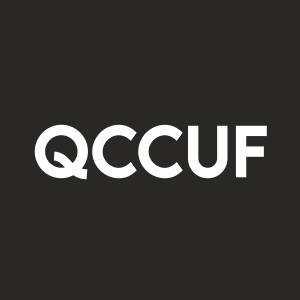QC Copper Reports Favourable Metallurgical Results, Confirms High-Quality Bulk Tonnage Concentrate to Come from the Opemiska Deposit
- Preliminary results indicate similar recoveries of copper and gold to historical mining operations. Copper recoveries range from 94% to 90% and gold recoveries range from 81% to 73%. Silver recoveries average between 79% and 71%. The company's proposed process without cyanide leaching contributes to high gold and silver recoveries.
- None.
Toronto, Ontario--(Newsfile Corp. - July 25, 2023) - QC Copper and Gold Inc. (TSXV: QCCU) (OTCQB: QCCUF) ("QC Copper" or the "Company") is pleased to announce preliminary results from its metallurgical testing program on samples from the Opemiska Copper-Gold Deposit.
Preliminary results from ongoing metallurgical studies indicate that recoveries of copper and gold on the Opemiska deposit mineralization are expected to be similar to the historical recoveries during mining operations between 1954 and 1991 despite a head grade for the open pit resource being much lower than the average grade mined underground, which results in lower recoveries. Results show copper recoveries between
"The reason gold recovery is so high in our proposed process that does not include cyanide leaching, is that much of the gold is found either as inclusions in chalcopyrite or as small grains attached to the mineral according to our QEMSCAN study. This allows the gold to float along with the chalcopyrite in the process leading to high gold and silver recoveries with little effort," said Charles Beaudry, Director, Vice President of Exploration for QC Copper and Qualified Person as defined in NI43-101.
Technical Details of the Opemiska Metallurgical Study
As part of the forthcoming updated mineral resource estimate, the Company commissioned SGS to study metallurgical and environmental samples from drill core from Opemiska Deposit. The Company's metallurgical program began in October 2022, and will be an ongoing process with the development of Opemiska.
Copper flotation circuits are typically composed of two parts: the rougher cells, which focus on recovering the maximum of copper from the ore, and the cleaner cells, meant to remove impurities to maximize the grade of the resulting concentrate while maintaining as high a recovery as possible.
For this testing, the rougher performance was evaluated with different grind sizes, and it concluded that a primary grind of 105 microns leads to shorter grind times while producing good recoveries. The rougher test yielded excellent copper recoveries in the
Four samples from different parts of the Opemiska deposit were submitted and processed with QEMSCAN to evaluate the copper minerals' liberation grain size and mineralogy. This study concluded that there was no difference between the four samples. Accordingly, a composite sample was processed for testing, including some grind tests and various rougher and cleaner tests to obtain the best results.
Additional work is being undertaken to characterize the environmental characteristics of the ore, waste and tailings. Preliminary results suggest no cause for concern for the project. However, it is apparent that not all hosts rocks show the same characteristics, particularly the pyroxenite host may have a different behaviour in the acid-base accounting test than the gabbro, which will be the subject of further testing. However, overall the pyroxenite represents a much smaller proportion of the deposit than the gabbro.
About the Opemiska Copper Complex
The Opemiska Copper Complex is located adjacent to Chapais, Quebec, within the Chibougamau district. Opemiska is also within the Abitibi Greenstone belt and within the boundaries of the Province of Quebec's Plan Nord, which promotes and funds infrastructure and development of natural resource projects. The greater Opemiska property, which includes the Ex-In option, the object of the current news release, covers 24,412 hectares and covers the past producing Springer, Perry, Robitaille and Cooke mines, previously-owned and operated by Falconbridge between 1953-1991. The project hosts excellent on-site infrastructure, including a power station and direct access to Highway 113 and the Canadian National Railway.
QP Statement
The technical information contained in this news release has been reviewed and approved by Charles Beaudry, P.Geo and géo., Director and Vice President Exploration for QC Copper & Gold, a Qualified Person, as defined in "National Instrument 43-101, Standards of Disclosure for Mineral Projects."
For information and updates on QC Copper and Gold, please visit: www.qccopper.com.
And please follow us on Twitter @qccoppergold.
To speak to the Company directly, please contact:
Stephen Stewart, Chief Executive Officer
Phone: 416.644.1567
Email: sstewart@qccopper.com
Neither TSX Venture Exchange nor its Regulation Services Provider (as that term is defined in the policies of the TSX Venture Exchange) accepts responsibility for the adequacy or accuracy of this release. Certain information in this press release may contain forward-looking statements. This information is based on current expectations that are subject to significant risks and uncertainties that are difficult to predict. Actual results might differ materially from results suggested in any forward-looking statements. QC Copper and Gold Inc. assumes no obligation to update the forward-looking statements, or to update the reasons why actual results could differ from those reflected in the forward-looking-statements unless and until required by securities laws applicable to QC Copper and Gold Inc. Additional information identifying risks and uncertainties is contained in filings by QC Copper and Gold Inc. with Canadian securities regulators, which filings are available under QC Copper and Gold Inc. profile at www.sedar.com.

To view the source version of this press release, please visit https://www.newsfilecorp.com/release/174781
FAQ
What are the preliminary results from QC Copper's metallurgical testing program?
What is the reason for high gold recovery in the proposed process?







